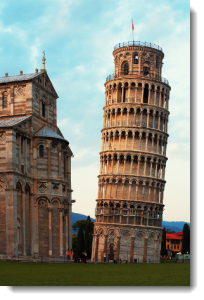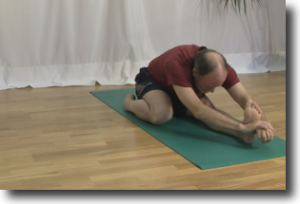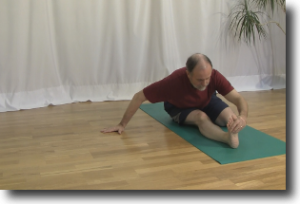Alice walks around the corner of the cathedral and then she sees it. She stops and looks closely at the tower. It has been leaning like that for over 800 years and it has not fallen down.
The leaning tower of Pisa reminds Alice of the the problem that she has when she does Triang Mukha Ekapada Paschimottanasana, except in her case the leaning tower does fall down.
There are few things that Alice can do to support and straighten her leaning tower in this pose.
What is Triang Mukha Ekapada Paschimottanasana
The Sanskrit name translates roughly as one leg folded with three limbs pointing forward pose. This is one of the seated poses that appears in the first half of the Primary series of Ashtanga Yoga.
Lengthening of the quadriceps is the primary focus of this posture. Secondarily the hamstrings and hip flexor muscles are stretched and lengthened when you fold forward. The back and shoulder muscles get some workout as well.
This pose is good for a lot of things, let’s see how to do the pose before we get into the leaning tower effect and how to correct it.
How to do Triang Mukha Ekapada Paschimottanasana
You start in Dandasana which means your are seated on the floor with both legs straight out in front of you and the back of your hips and torso are vertical to the floor
Next you close the right knee joint and bring your right foot back beside your hip and put the top of your foot and shin on the floor. Your right thigh is parallel to your left thigh and your right foot is beside your hip and not underneath it. When you have your foot in the right place you can slide your hand between your hip and your foot. Both your the bones of your hip are on the floor.
Now you tip your hips and torso forward and bring your arms forward and eventually you hold your left foot with your hands.
Finally gaze towards your toes and hold the pose for several breaths.
You may discover that when you attempt this pose that your torso is leaning towards your left side. You may even fall to the ground unlike the leaning tower of Pisa which has resisted falling down for over 800 years.
What is the problem with Triang Mukha Ekapada Paschimottanasana
There are two problems that occur in this pose that make you have the leaning tower effect:
- You may have stiff ankle joints that prevent the top of your foot from resting comfortably on the floor.
- Your Quadriceps may be tight and shortened preventing the knee joint from completely closing and allowing your hips to rest on the floor beside your foot.
Both of these problem can result in you looking like the leaning tower of Pisa. The second problem more so than the first one will create the leaning tower effect.
There are a few modifications that Alice can do to work around these problems.
How can Alice modify the pose to remove the leaning tower of Pisa effect
There are three stages of flexibility in this pose that Alice needs to work through.
Stage 1 – The tower falls down
You are in this Stage if both of your hips are off of the floor and the top of your ankle is in the air. As a result your torso is tipping over to the side even more than the leaning tower of Pisa and you will fall over if your do not put your arm out to support yourself.
In this stage you need to do two things:
- Place and eye pillow or sand bag under your ankle of the folded leg to support the ankle and allow the muscles of the top of the foot to relax.
- Place a blanket or block of sufficient thickness under your hips. You need enough thickness to take the pressure off of your quadriceps and knee.
Once you have these props in place the leaning tower effect should be gone and you will be able to safely fold forward without worrying about falling over on to your side.
After repeating this pose several times with these supports you will start to lengthen your muscles and you will be ready for the next stage where the tower is leaning but not falling down.
Stage 2 – The tower is leaning but not falling down
You are in this stage if you are able to get the hip that is away from the folded leg to the floor and you are leaning to the side but you are not falling over.
In this stage you use your arm to reduce the leaning tower effect. There are no props involved in this stage of the posture.
Once you have entered the posture and before you fold forward take your arm out the side and place you hand on the floor roughly in line with your knee. Your arm is going to hold your leaning tower up and actually push it back toward a vertical position as you fold forward.
It will take some experimenting to get you arm and hand in the right place so that you can support your torso and remove the leaning tower effect as you fold forward.
Eventually after many repetitions the leaning tower effect will gradually disappear and then you will be entering into the final stage of the posture.
Stage 3 – The leaning tower is gone
In this stage both sitz bones of the hip are touching the floor, however the weight distribution is not balanced evenly on each sitz bone.
There is no arm out to the side in this stage of the posture. You are using the muscles of your body, in particular Uddiyana Bandha which is the lower abdomen muscle lock. Engaging Uddiyana Bandha will help to stabilize your core and gradually lower the slightly raised sitz bone towards the floor.
There are a few mistakes that Alice should watch out for in this pose.
The foot of your folded leg is turned out to the side
This usually happens when the ankle joint is tight and the top of the foot will not come to the floor. To relieve the tension in the ankle joint a lot of people will turn the toes out to the side and lower the heel towards the floor. You want to avoid this movement.
Turning the foot out to the side will put stress on the knee joint because the shin is turned to the side while the thigh is straight up and down. The knee joint is not meant to move from side to side and the ligaments can get injured if you do this.
The heel of the foot should be pointing straight up and all five toes should be touching the floor. If you need to support the ankle and take some stress off of the muscles in the joint then place an eye pillow or sand bag under the ankle.
There is one more common mistake and it also involves the folded leg.
Sitting on the heel of the folded leg
Some people will sit on the heel of the folded leg when their hips will not reach the floor. Sitting on the heel will remove the pressure and tension in the quadriceps however this is not the proper way to do the pose. You will not gain the benefits of the pose while you are sitting on the heel.
You should be sitting on the floor with the heel of the foot pointing towards the ceiling. You should be able to slide a hand between your heel and your hip.
If you hip is not reaching the floor then you should put a support under your hip to take some pressure off of the quadriceps muscles and the knee joint. Over time as your flexibility improves you can reduce the size of the support that you are using.
Summary
To remove the leaning tower of Pisa effect from Triang Mukha Ekapada Paschimottanasana Alice can do a few things.
- support her hips with some props if her tower is falling over
- use her arm out to the side as a support if her tower is leaning but not falling over.
While Alice was in Pisa she got a picture taken of her using her arms to hold up the leaning tower of Pisa much like she uses her arms to support her torso in Triang Mukha Ekapada Pashimottanasana.
Next Step
Work with your yoga teacher to find out which stage you are in and to find out which modification you should be doing to support your leaning tower.
Alice walks around the corner of the cathedral and then she sees it. She stops and looks closely at the tower. It has been leaning like that for over 800 years and it has not fallen down.The leaning tower of Pisa reminds Alice of the the problem that she has when she does Triang Mukha Ekapada Pashimottasana. Except in her case the leaning tower does fall down.
There are few things that Alice can do to support and straighten her leaning tower in this pose.
What is Triang Mukha Ekapada Pashimottasana
The Sanskrit name translates roughly as One leg forward fold with three limbs pointing forward pose. This is one of the seated poses that appears in the first half of the Primary series of Ashtanga Yoga.
Lengthening of the quadriceps is the primary focus of this posture. Secondarily the hamstrings and hip flexor muscles are stretched and lengthened when you fold forward. The back and shoulder muscles get some workout as well.
This pose is good for a lot of things, let’s see how to do the pose before we get into the leaning tower effect and how to correct it.
How to do Triang Mukha Ekapada Pashimottasana
— Start in Dandasana which is seated on the floor with both legs straight out in front of you and the back of the hips and torso are vertical to the floor
— close the right knee joint
— bring the right foot back beside the hip and put the top of the foot and the shin on the floor.
— the right thigh is parallel to the left thigh.
— the right foot is beside the hip and not underneath it
— you can slide your hand between your hip and your foot
— both sitz bones of the hip are on the floor
— tip the hips and torso forward.
— bring the arms forward and eventually hold the left foot with your hands
— gaze towards your toes
— hold for several breaths
You may discover that when you attempt this pose that your torso is leaning towards your left side. You may even fall to the ground unlike the leaning tower of Pisa which has resisted falling down for over 800 years.
What is the problem with Triang Mukha Ekapada Pashimottasana
There are two problems that occur in this pose that make you have the leaning tower effect:
1 — You may have stiff ankle joints that prevent the top of your foot from resting comfortably on the floor.
2 — Your Quadriceps may be tight and shortened preventing the knee joint from completely closing and allowing your hips to rest on the floor beside your foot.
Both of these problem can result in you looking like the tower of Pisa. The second problem more so than the first one will create the leaning tower effect.
There are a few modifications that Alice can do to work around these problems.
How can Alice modify the pose to remove the leaning tower of Pisa effect
There are three stages of flexibility in this pose that Alice needs to work through.
Stage 1 – The tower falls down
You are in this Stage if both of your hips are off of the floor and the top of your ankle is in the air. As a result your torso is tipping over to the side even more than the leaning tower of Pisa and you will fall over if your do not put your arm out to support yourself.
In this stage you need to do two things:
1 — Place and eye pillow or sand bag under your ankle of the folded leg to support the ankle and allow the muscles of the top of the foot to relax.
2 — Place a blanket or block of sufficient thickness under your hips. You need enough thickness to take the pressure off of your quadriceps and knee.
Once you have these props in place the leaning tower effect should be gone and you will be able to safely fold forward without worrying about falling over on to your side.
After repeating this pose several times with these supports you will start to lengthen your muscles and you will be ready for the next stage where the tower is leaning but not falling down.
Stage 2 – The tower is leaning but not falling down
You are in this stage if you are able to get the hip that is away from the folded leg to the floor and you are leaning to the side but you are not falling over.
In this stage you use your arm to reduce the leaning tower effect. There are no props involved in this stage of the posture.
Once you have entered the posture and before you fold forward take your arm out the side and place you hand on the floor roughly in line with your knee. Your arm is going to hold your leaning tower up and actually push it back toward a vertical position as you fold forward.
It will take some experimenting to get you arm and hand in the right place so that you can support your torso and remove the leaning tower effect as you fold forward.
Eventually after many repetitions the leaning tower effect will gradually disappear and then you will be entering into the final stage of the posture.
Stage 3 – The leaning tower is gone
In this stage both sitz bones of the hip are touching the floor, however the weight distribution is not balanced evenly on each sitz bone.
There is no arm out to the side in this stage of the posture. You are using the muscles of your body, in particular Uddiyana Bandha which is the lower abdomen muscle lock. Engaging Uddiyana Bandha will help to stabilize your core and gradually lower the slightly raised sitz bone towards the floor.
There are a few mistakes that Alice should watch out for in this pose.
The foot of your folded leg is turned out to the side
This usually happens when the ankle joint is tight and the top of the foot will not come to the floor. To relieve the tension in the ankle joint a lot of people will turn the toes out to the side and lower the heel towards the floor. You want to avoid this movement.
Turning the foot out to the side will put stress on the knee joint because the shin is turned to the side while the thigh is straight up and down. The knee joint is not meant to move from side to side and the ligaments can get injured if you do this.
The heel of the foot should be pointing straight up and all five toes should be touching the floor. If you need to support the ankle and take some stress off of the muscles in the joint then place an eye pillow or sand bag under the ankle.
There is one more common mistake and it also involves the folded leg.
Sitting on the heel of the folded leg
Some people will sit on the heel of the folded leg when their hips will not reach the floor. Sitting on the heel will remove the pressure and tension in the quadriceps however this is not the proper way to do the pose. You will not gain the benefits of the pose while you are sitting on the heel.
You should be sitting on the floor with the heel of the foot pointing towards the ceiling. You should be able to slide a hand between your heel and your hip.
If you hip is not reaching the floor then you should put a support under your hip to take some pressure off of the quadriceps muscles and the knee joint. Over time as your flexibility improves you can reduce the size of the support that you are using.
Summary
To remove the leaning tower of Pisa effect from Triang Mukha Ekapada Pashimottasana Alice can do a few things.
1 — support the hips with some props if your tower is falling over
2 — use your arm out to the side as a support if your tower is leaning but not falling over.
While Alice was in Pisa she got a picture taken of her using her arms to hold up the leaning tower of Pisa much like she uses her arms to support her torso in Triang Mukha Ekapada Pashimottasana.
Next Step
Work with your yoga teacher to find out which stage you are in and to find out which modification you should be doing to support your leaning tower.






